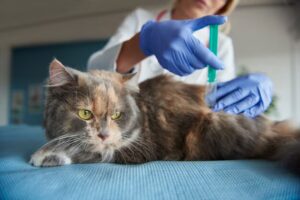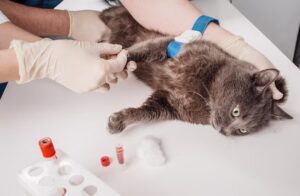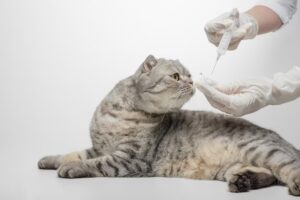Feline Leukemia Virus (FeLV) is a retrovirus and it was first identified in the 1960s and has since become a significant health concern for cats worldwide. FeLV can lead to various health problems, including immunosuppression, anemia, and the development of certain types of cancers.
FeLV is primarily transmitted through close contact between cats, such as grooming, biting, or sharing food and water bowls. It can also be transmitted from an infected mother cat to her kittens during pregnancy, birth, or through nursing. Additionally, FeLV can survive for a limited time in the environment, so indirect transmission through shared litter boxes or bedding is possible, although less common.

1. Transmission:

- Direct contact: FeLV is most commonly transmitted through close contact between infected cats and healthy cats. This can be through activities such as grooming, biting, and sharing food and water bowls.
- Saliva: Infected cats shed the virus in their saliva, so grooming and biting can lead to transmission.
- Nasal secretions: Sneezing and the presence of infected cats can cause transmission through respiratory secretions.
- Body Fluids: FeLV may be present in other body fluids such as urine, feces, and milk. Transmission can occur through sharing litter boxes, grooming each other, or being fed by an infected mother.
- Bites: Aggressive behavior or arguments between cats can lead to transmission through bites.
- Vertical Transmission: Pregnant cats can transmit FeLV to their kittens via the placenta or during lactation.
- Shared Environment: Cats that live in confined spaces, e.g. Those in multi-cat houses or kennels are at higher risk of being FeLV carriers due to increased opportunities for close contact.
You Should Know That : 7 Impressive Facts: Feline Immunodeficiency Virus
2. Symptoms:
- Weight loss
- Lethargy
- Loss of appetite
- Enlarged lymph nodes
- Pale gums
- Recurrent infections
- Development of tumors
3. Preventing of Feline Leukemia Virus:

- Vaccination: Consult your veterinarian about vaccinating your cat against FeLV. The FeLV vaccine is typically recommended for kittens and cats that have a higher risk of exposure, such as outdoor cats or those living with infected cats. Vaccination can significantly reduce the risk of FeLV infection.
- Indoor Living: Keeping your cat indoors can greatly reduce the risk of exposure to Feline Leukemia Virus (FeLV) and other infectious diseases. Indoor cats are less likely to come into contact with infected cats and environments.
- Testing: If you have a new cat or kitten, it’s a good idea to have them tested for Feline Leukemia Virus (FeLV) before introducing them to your existing cats. Testing can help identify any potential carriers and prevent transmission.
- Isolation: If you bring a new cat into your household, isolate them from your existing cats for a period of time (usually a few weeks) while monitoring for signs of illness. This can help prevent the potential spread of infections.
- Spaying and Neutering: Sterilizing your cats can reduce their inclination to roam and fight, which can decrease their exposure to FeLV and other diseases.
- Regular Veterinary Care: Schedule regular check-ups with your veterinarian to monitor your cat’s health and address any concerns promptly. Veterinarians can also recommend appropriate preventive measures based on your cat’s lifestyle.
- Hygiene and Sanitation: Keep your cat’s living environment clean by regularly cleaning litter boxes, food and water bowls, and other surfaces. This can help minimize the risk of disease transmission.
- Avoid Sharing Items: If you have multiple cats, avoid sharing items like food bowls, water bowls, and litter boxes to prevent the potential spread of infections.
- Supervise Outdoor Activities: If your cat goes outdoors, supervise their activities and provide a safe and enclosed outdoor space to reduce their exposure to infected cats.
- Education: Educate yourself about FeLV and other feline diseases. Understanding the risks and prevention strategies can help you make informed decisions about your cat’s care.
Remember that no preventive measure is guaranteed to completely eliminate the risk of FeLV. However, by following these recommendations and working closely with your veterinarian, you can significantly reduce the likelihood of your cat contracting FeLV or other contagious diseases.
Must See This: 2 Most Important Types Of Diabetes in Cats
4. Treatment of Feline Leukemia Virus:
Unfortunately, there is no cure for Feline Leukemia Virus (FeLV), and the treatment mainly focuses on managing the symptoms and providing supportive care to improve the cat’s quality of life. The specific treatment approach will depend on the cat’s individual condition and the symptoms they are experiencing. Here are some aspects of FeLV management:

- Symptomatic Care: Treatment may involve addressing specific symptoms such as anemia, secondary infections, or gastrointestinal issues. Medications, blood transfusions, and other medical interventions may be used as needed.
- Immune Support: Boosting the immune system can help the cat’s body better cope with FeLV. This may involve nutritional support, immune-boosting supplements, and providing a stress-free environment.
- Antiviral Therapy: Some antiviral drugs may be used to help manage the replication of the FeLV virus. However, these treatments are generally not curative and may have limitations in their effectiveness.
- Secondary Infection Management: FeLV-positive cats are more susceptible to other infections due to their weakened immune systems. Treating any secondary infections promptly is important for the cat’s overall health.
- Nutritional Support: Proper nutrition is crucial for FeLV-positive cats. A balanced diet and appropriate caloric intake can help maintain their strength and immune function.
- Fluid and Electrolyte Balance: FeLV-positive cats may experience dehydration and electrolyte imbalances, so maintaining proper fluid and electrolyte balance is important.
- Regular Veterinary Monitoring: Regular veterinary check-ups and blood tests can help monitor the cat’s condition, detect any changes, and adjust the treatment plan accordingly.
Conclusion:
In conclusion, Feline Leukemia Virus poses a considerable threat to the feline population, particularly those with compromised immune systems, young kittens, and elderly cats. Preventive measures such as vaccination, regular veterinary check-ups, and keeping infected and non-infected cats separate can help reduce the spread of the virus. Early detection and appropriate management are crucial for improving the prognosis of infected cats and preventing further transmission. It’s essential for cat owners and caregivers to be informed about FeLV, its transmission, symptoms, and preventive measures to ensure the health and well-being of their feline companions
FAQ’s:
What is feline leukemia virus (FeLV) and how do cats get it?
FeLV is a viral infection that affects cats. Transmission occurs primarily through close contact such as grooming and biting, but can also be transmitted from an infected female cat to her kittens during birth or through milk.
What are the symptoms of FeLV in cats and how to recognize them?
FeLV can cause a variety of symptoms, including weight loss, lethargy, pale gums, recurring infections, and even cancer. Some cats may not show any symptoms for years. Regular veterinary check-ups are essential for early diagnosis.
Does FeLV infect other animals or humans?
FeLV is specific to cats and poses no immediate danger to humans or other non-feline pets. However, it can be transmitted between cats, particularly through close contact.
Can FeLV be prevented and how can I prevent my cat from catching the virus?
FeLV can be prevented by vaccination and separating infected and uninfected cats. Regular veterinary care and check-ups are essential to monitor your cat’s health and reduce the risk of exposure.
Are all cats equally susceptible to FeLV, or are some cats more at risk than others?
Cats with compromised immune systems, such as kittens, older cats, and cats with other health conditions are more susceptible to FeLV. Outdoor cats that fight or interact closely with other cats are also at higher risk of contracting the virus.
You Should Visit: Vetpomedix.com


